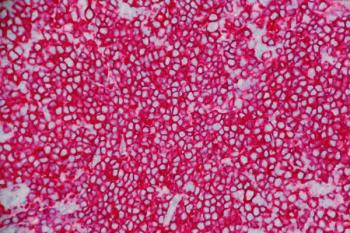
Olaparib Found to Significantly Improve Survival in High-Risk Early Breast Cancer
Olaparib (Lynparza) was found to significantly improve overall survival in patients with germline BRCA-mutated, HER2-negative, high-risk early breast cancer.
Treatment with olaparib (Lynparza) was found to significantly improve overall survival (OS) compared with placebo in patients with germline BRCA-mutated, human epidermal growth factor receptor 2 (HER2)-negative, high-risk early
These data, presented at the
At that time, an improvement in OS was observed with olaparib compared with placebo, but the numerical benefit was not found to be of statistical significance (HR, 0.68; 99% CI, 0.44-1.05; P = .024). The P value needed for significance was 0.010. The 3-year OS rate difference was 3.8% (95% CI, 0.9%-6.6%) for olaparib, and the 4-year difference was 3.4% (95% CI, -0.1 to 6.8).
“At a median follow-up of 3.5 years, effect sizes and absolute differences remain consistent with the previous primary analysis, with tightening 95% CIs across invasive disease-free survival [iDFS], distant disease-free survival [DDFS], and OS end points,” Andrew Tutt, MD, PhD, director of the Breast Cancer Now Research Unit at King’s College London, and honorary consultant clinical oncologist of the Breast Unit at Guy’s Hospital, GSTT, said in a presentation on the data.2 “Olaparib after local treatment and (neo)adjuvant chemotherapy significantly improves IDFS, DDFS, and OS with limited, manageable toxicity and without new safety signals.”
The multicenter, placebo-controlled trial enrolled 1836 patients with HER2-negative breast cancer with a germline BRCA mutation, who were randomized 1:1 to receive either olaparib at a twice-daily dose of 300 mg (n = 921) or placebo twice daily (n = 915) for 1 year. Patients had to be at high risk for disease recurrence, treated for stage II or III breast
The primary end point of the trial was iDFS, with key secondary end points of DDFS, OS, health-related quality of life, and safety. Patients were stratified by whether they had hormone receptor–positive disease versus triple-negative disease, received neoadjuvant versus adjuvant treatment, or whether they were administered prior platinum-based chemotherapy or not.
Patients had an average of 42 years (range, 36-49) in the olaparib cohort compared with 43 years (range, 36-50) in the placebo cohort. Further, 71.3% of patients in the investigative cohort and 73.2% of patients in the control cohort had tumors with BRCA1 germline mutations; 28.3% and 26.1% of patients, respectively had BRCA2 mutations.
The most performed primary breast cancer surgery was mastectomy, which was performed in 75.8% of patients in the olaparib cohort compared with 73.6% of patients in the placebo cohort. Further, 81.5% of patients in the investigative cohort and 82.8% of patients in the control cohort had triple-negative disease.
At the time of the updated analysis, 14.5% of patients in the olaparib cohort and 22.6% of patients in the placebo group experienced their first iDFS event. Distant recurrence was found in 9.6% of patients in the investigative cohort compared with 14.9% of patients in the control group; regional recurrence was observed in 1.0% and 2.0% of patients, respectively; local (ipsilateral) recurrence was found in 1.0% and 1.3% of patients, respectively; and contralateral invasive breast cancer was observed in 1.6% and 2.0% of patients, respectively.
Second primary non-breast malignancies were found in 1.2% of patients administered olaparib and 2.5% of patients administered placebo. One patient In the investigative arm developed ovarian cancer, 1 patient developed fallopian tube cancer, and 9 patients had an unspecified malignancy. Two patients in the olaparib cohort died without an iDFS event compared with no patients in the placebo arm.
Seventy-five patients in the olaparib group died compared with 109 patients in the placebo cohort. The primary cause of death in the investigative cohort was disease recurrence, which occurred in 93.3% of patients, 2.7% of patients died from an adverse effect (AE), and 4.0% of patients died from another unspecified reason. In the control group, 94.5% died from breast cancer recurrence, 3.7% died from a toxicity, and 1.8% died from another unspecified reason.
Any-grade AEs were found in 91.8% of patients administered olaparib compared with 83.8% of patients administered placebo. Grade 3 or higher AEs were reported in 24.5% and 11.3% of patients, respectively. Grade 4 toxicities were reported by 1.9% of patients in the investigative cohort compared with 0.4% of patients in the control group. Serious AEs were reported in 8.7% and 8.6% of patients, respectively.
In the investigative cohort, toxicities of special interest included myelodysplastic syndrome/acute myeloid leukemia (0.2%), pneumonitis (1.0%), and a new primary malignancy (2.3%). Further, 10.8% of patients in the investigative group experienced a toxicity that resulted in treatment discontinuation compared with 4.6% of patients in the control group. No additional toxicities leading to death were reported since the previous analysis.
Common toxicities experienced by 10% or more of patients administered olaparib included nausea (57%), fatigue (40%), anemia (24%), vomiting (23%), headache (20%), diarrhea (18%), neutropenia (16%), leukopenia (16%), decreased appetite (13%), dysgeusia (12%), dizziness (11%), and arthralgia (10%). The most frequent grade 3 or higher toxicities were anemia (9%), neutropenia (5%), leukopenia (3%), and fatigue (2%).
“Treatment effect [with olaparib] was consistent, without evidence of significant heterogeneity, across major subgroups including the BRCA1, BRCA2, hormone receptor–positive, and triple-negative subsets,” Tutt said in the release.
References
- Tutt ANJ, Garber J, Gelber RD, et al. Pre-specified event driven analysis of overall survival (OS) in the OlympiA phase III trial of adjuvant olaparib (ol) in germline BRCA1/2 mutation (gBRCAm) associated breast cancer. Presented at: March 2022 ESMO Virtual Plenary; March 16-18, 2022; virtual. Accessed March 16, 2022.
- LYNPARZA® (olaparib) Reduced Risk of Death by 32% in Patients With Germline BRCA-Mutated, HER2-Negative High-Risk Early Breast Cancer in Phase 3 OlympiA Trial. Merck. [news release]. March 16, 2022.
https://www.merck.com/news/lynparza-olaparib-reduced-risk-of-death-by-32-in-patients-with-germline-brca-mutated-her2-negative-high-risk-early-breast-cancer-in-phase-3-olympia-trial/
Newsletter
Stay informed on drug updates, treatment guidelines, and pharmacy practice trends—subscribe to Pharmacy Times for weekly clinical insights.














































































































































































































